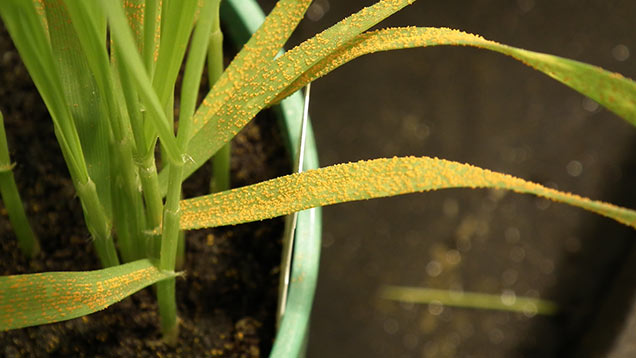Cereal disease threat may be worse than in ‘horrific’ 2014

Cereal growers could face a worse disease year this season than the “horrific” 2014 prompted by a mild autumn with plenty of inoculum in fields.
Wheat’s most damaging diseases – septoria and yellow rust (pictured) – are being seen earlier than normal while in barley, mildew, rhynchosporium and net blotch are worse than usual.
Scottish disease expert Fiona Burnett is warning that 2015 could be more serious than 2014 with lots of early-drilled and forward crops picking up disease in the autumn.
See also: Ramularia early warning scheme to reach all UK barley growers in 2016
“We have forward, thick crops, the right weather and enough inoculum to start the fire,” she tells the Farmers Weekly.
Dr Burnett, crop protection leader at Scotland’s Rural College (SRUC), adds she is seeing more yellow rust and septoria in crops at this stage than for a long time.
Yellow rust crept into East Lothian winter wheat crops by early November, two months ahead of normal, while septoria is being seen in many crops.
“We have only had a little bit of cold weather, what we need is sustained cold weather to kill off disease,” she says.
All the signs are that disease could be worse than in 2014 which she describes as a “horrific disease year” largely due to the mild 2013-14 winter.
Dr Burnett advises growers should hold their nerve and focus on getting the timing right for their first T0 fungicide, generally in March, as she is not a great advocate of applying pre-T0 sprays early in the season.
She suggests that a T0 winter wheat spray could be based on generally cheaper azole fungicides tebuconazole and cyproconazole along with protective product chlorothalonil.
Where septoria is a big threat then growers should look at higher rates of azoles, but try and hold back the most effective two – prothioconazole and epoxiconazole – for later sprays.
At the T1 spray timing in April, she advises using one of these two azoles plus chlorothalonil, and look to increase the azole rate and consider an SDHI fungicide if the disease risk is high.
Further south in Herefordshire, fungicide expert Jonathan Blake at crop scientist group Adas says disease levels will depend heavily on the coming weather in February and March.
He is seeing yellow and brown rust in susceptible wheat varieties and septoria in most crops after the mild and wet autumn and early winter, although colder weather is now forecast for February.
“Severe frosts will take out rusts and indirectly reduce the septoria pressure,” he says.
A number of significant night frosts below -5C will kill off lower leaves infected with rusts, while a cold spring will reduce the septoria risk as the disease thrives in warm wet weather in March/April/May.

